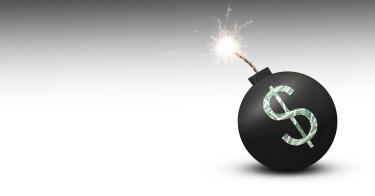In a classic case of outsmarting themselves, the economists at the Fed seemed to have found a way to create money for the government to spend while avoiding the negative consequences, chiefly inflation. But the ramifications of this monetary malfeasance were only delayed, not denied. To understand why, we need to go back to the last time the Fed avoided massive inflation after record-setting money creation: the 2008 global financial crisis.
In the wake of the housing and financial crises, both the outgoing Bush and incoming Obama administrations spent record amounts on bailouts and exploded the national debt. Many conservatives sounded the financial alarm, warning of impending inflation reminiscent of the 1970s.
Despite the Fed’s creating $4.8 trillion to finance government overspending and gobble up mortgage loans that were being liquidated, inflation was relatively tame in the following decade. But how did the Federal Reserve create money for the government to spend without unleashing inflation?
The mechanics of fractional-reserve banking can help us answer that question. When a customer deposits a dollar, the bank traditionally loans out 90 cents (90 percent), leaving ten cents behind as a reserve. This is called a 10 percent reserve ratio. Because depositors don’t usually all ask for their entire balances at once, it’s not a problem for the bank to only have 10 percent in reserves.
>>> Central Banks Can’t Avoid the Consequences of Their Actions
The 90 cents created through those loans are eventually placed on deposit somewhere else, where an additional 81 cents (90 percent of 90 cents) are loaned out. The process repeats until that single dollar deposit in the banking system has created another nine dollars in loans. This is how fractional-reserve banking creates money out of debt. But it needs a deposit to start the ball rolling.
The Fed has no such limitation. Instead, the Fed buys government bonds, providing the Treasury with cash by simply typing a number in their account. Then, as the government spends that money, that same fractional-reserve process multiplies it to, not $9 as before, but $10 fresh dollars in the money supply.
This means if the Fed buys $100 billion in government bonds, it will ultimately grow the money supply by $1 trillion—equivalent to 5 percent inflation, given the money supply of approximately $20 trillion.
This inflationary impact is well-known, and the Fed had to face it during the financial crisis. The solution they found was to “sterilize” the new money by encouraging banks to keep it in the vault rather than lending it out. It did this by paying them interest to keep excess reserves at the Fed itself rather than loan it out. This avoided fractional-reserve multiplication, so it looked like a free lunch to the Fed: It could print money for the government to spend, but because it was parked at the Fed, the increase in the money supply was only a tenth of the anticipated gain, yielding much less inflation than expected.
The Fed tried something similar on the eve of the Great Depression in 1928 when it attempted to create money but keep it away from the speculative frenzy of stock markets. The Fed purchased a debt instrument called bankers’ acceptances, which were used to finance international trade. It was believed this would steer the newly created money towards international merchants and not to stockbrokers. Alas, it didn’t work. The inflow of liquidity caused interest rates everywhere to fall as the new money circulated beyond international trade. That kept the rates on margin loans low, and the speculative binge continued. Once money is in circulation, its fungibility makes it uncontrollable—it “leaks.” So, the only solution was to prevent it from going into circulation. Thus, the Fed’s response after the financial crisis.
The Fed had seemingly pulled off the impossible. Many fiscal conservatives were left scratching their heads, waiting for the inflation that never came. Of course, another thing that never came was robust economic growth: The Great Recession marked one of the slowest economic recoveries in the post-war era. To keep a lid on inflation, the Fed had sucked liquidity out of the private sector, which hamstrung investment, a key driver of economic growth.
Now, less than 15 years later, the Fed has once again responded to unprecedented deficit spending with equally unprecedented monetary machinations.
In March 2021, the Fed knew inflation was coming but thought it had another ace to play: the Reverse Repurchase Agreement (“reverse repo”) market. These are short-term transactions, typically 24-hour loans with a debt obligation serving as collateral. In other words, the Fed borrows money for a day from private institutions, which temporarily receive a Treasury bond until the Fed returns the borrowed money the next day, with interest.
Reverse repos are a way for the Fed to temporarily soak up excess liquidity in the market. But this is just a stopgap measure until the Fed can sell bonds in its open-market operations. Selling a bond is like the first part of a reverse repo without the second—the Fed gives a bond to a bank, and the bank pays for it in cash, but there is no repurchase 24 hours later.
Selling bonds would have been the prudent move for the Fed and put a stop to the river of free cash for Congress and the White House by pushing up interest rates on Treasuries to prohibitively expensive levels. Instead, the Fed kept the federal spree going, buying bonds while simultaneously escalating its reverse repos—as if the Fed’s right hand did not know what the left hand was doing.
This allowed the Fed to create unprecedented levels of cash for Congress to spend, while also keeping it out of the banking system. And unlike paying interest on reserves, which only captures deposits at banks, the reverse-repo market was expanded in April 2021 to include other financial institutions with large cash balances, such as reinsurance companies and money-market funds.
Just how much cash is the Fed keeping out of the market with reverse repos? At this point, $2.4 trillion. That’s more than the $2.3 trillion of physical currency currently in circulation.
Terrible though inflation has been over the last year, it would have been far worse if the Fed hadn’t been playing these games behind the scenes. But this practice is merely a delaying tactic—and the Fed is running on borrowed time.
Like paying interest on reserves, the Fed pays interest on reverse repos too. That is a cost to the Treasury and ultimately the taxpayer. As interest rates rise, the Fed must raise the rates it pays on reverse repos, or it cannot attract the inflation-suppressing funds out of the financial system. These interest payments effectively inject small amounts of liquidity daily—precisely the opposite of what the Fed is trying to achieve by decreasing the size of its balance sheet.
This will lead to a vicious cycle wherein higher interest payments and higher interest rates feed off one another. Ballooning the reverse-repo market to previously unimagined levels and treating it like a long-term solution is unsustainable. Even worse, the Fed cannot simply stop reverse-repo operations overnight because it already removed the reserve requirement from banks in March 2020. This was allegedly done in response to illiquidity fears at the outbreak of the pandemic, but it is unclear why the Fed made this change permanent instead of temporary. The move was not only unprecedented, but incredibly dangerous.
>>> Don’t Give an Inch on the Debt Ceiling
By removing reserve requirements, the Fed has potentially green-lighted much higher levels of fractional-reserve money creation (the “fraction” is 0 percent), while perversely encouraging banks to raise leverage just 15 years after Wall Street was nearly leveled from over-leverage. As of now, a single dollar, with no reserve requirement, can multiply infinitely. Although capital-adequacy rules would theoretically provide some braking action, the risk profiles assigned to some assets may no longer be applicable in such an overleveraged financial system. In that case, leverage can continue to increase, and dollars multiply, while artificially maintaining capital-adequacy ratios.
This last year’s inflation is nothing compared to the beast growing at the Fed. If the central bank accidentally lets it loose, it risks setting off hyperinflation—and that’s not hyperbolic. The Fed is fumbling with a machine it barely understands, as Jerome Powell has admitted. The consequences could be catastrophic.
Although the Fed’s interest on reserves and reverse repos have succeeded in bringing inflation down slightly from four-decade highs, the central bank’s current path is already costing the Treasury billions and will eventually collapse in on itself. The laws of supply and demand will not be conned. The Fed must return to sound banking practices before it’s too late.
That means allowing interest rates to rise much higher, much faster, until inflation is under control and the federal government is forced to stop its spending spree. Given the short-run economic pain of hiking rates, that’s an ugly prospect. But the Fed’s recklessness has made it inevitable, and the longer it delays, the greater the problems it is stirring up.
This piece originally appeared in The National Review




